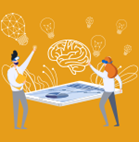AR and VR are two leading technologies that have the potential to create disruption for the better, across industries. The education industry has been quick to adopt augmented reality and virtual reality technologies in the era of online classes due to the Covid-19 lockdown worldwide. The best way to describe the potential impact of implementation of VR and AR in education is that it can make learning faster and deeper. In an ever-changing environment, our education system is required to keep pace with new technologies to stay relevant. Augmented reality and Virtual Reality could be the technologies to catalyze the evolution and transformation of the education system. From a business perspective, solutions of AR and VR in education come with easily applicable business models. This can be a great selling point. For students, virtual and augmented reality technology can create an immersive world of learning. For instance, studying the solar system through VR is going to take the experience of learning about the planets and sun to a whole new level. These immersive experiences will help ignite the imagination in children and transform the entire learning process itself.

Benefits of Using AR and VR in Education
AR and VR technology will continue playing a major role in the education system. AR can render objects that are difficult to imagine, by turning them into 3D models. This in turn makes it easier for students to grasp difficult concepts and abstract content. This is great for visual learners. With this, any student will be able to translate theoretical material into a practical concept.
Let’s take a brief look at how Virtual and Augmented Reality technology can help in solving some problems in the education system.
Practical Learning
: Even the most difficult subjects and topics can be integrated with augmented reality technology. It will help students understand at a conceptual level. The students can be given a PDF file or AR math activities. Thereafter, with the help of AR technology, the student can point a smartphone or tablet on top of the PDF file or paper in computer to check out the videos about the theoretical material. This trend of merging technology with conventional learning can make learning itself more fun and exciting than traditional approaches.
Interaction
: Use of AR and VR in education helps and brings physical experiences to a digital world. For example, the physical experience of turning the book and turning the pages can be brought to the interaction on a digital screen and the content can leap out of the pages to give the student a magical and immersive experience. For instance, students can engage in 3D animation, narration, and sound for better learning.
Range and Precision
: Using these VR and AR technologies, students can connect with their teachers from anywhere they want and, therefore, help in truly democratizing education on a global level. Diversity in content brings out the true perspective of the range of things that can be achieved. For some subjects or topics, AR/VR-based applications have the option to answer questions by typing into their tablets or laptops while the teachers and students can be in the same session.

Challenges in Today's World for AR and VR Adoption
The following challenges of AR and VR are negatively affecting the adoption of the technology in the education industry.

Hardware Issues:
At present, every available VR headset comes at a hefty price. It can be too expensive for the masses. Additionally, the VR headsets have to be tethered to the computer. This can be difficult for students and the experience becomes inconvenient and limiting.

Limited Content:
One of the primary challenges of VR and AR technology is creating engaging content. The content developed for AR and VR devices consists of games. However, creating content for educational purposes can be complicated and expensive.

Lack of Regulations:
At present, there are no regulations that help students and educational institutions understand the type of AR and VR technologies that can be used and how to use them. This can lead to cybercrime and loss of data for the educational institution. One of the significant challenges of these technologies is creating regulations that can ascertain the privacy and security of consumer data and mainstream adoption of the technology.

Skepticism:
Even though it is a popular topic of discussion for experts, many educational facilities are still unaware of the benefits of these technologies. Hence, they need to be informed about the different applications and benefits of this technology. As per a report by US Army Research Institute for Behavioral and Social Sciences, the actual problem is that technology can’t prove to be effective till there is a fundamental change in the school curriculum. This creates a standoff between the progress to adopt AR and VR technologies until the curriculum is changed.

Role of Content and Data for AR and VR Technologies
Virtual Reality and Augmented Reality can change the way we interpret and interact with data. 3D visualization in mixed reality is the right tool to help students understand. They can gain insight from huge data sets.
For it to be successful, immersive content and accurate data play a significant role. With this, AR and VR can deliver realistic physical and psychological experiences through immersive real-life simulations in a safe environment.
One of the primary roadblocks for the implementation of VR and AR solutions in education is largely practical. It takes great effort to create quality AR and VR content that covers the need of educational programs.
The basic AR and VR tools available in the market aren’t sufficient for creating engaging content. These can be used as supplements but not substitute. Furthermore, teachers cannot do immersive experiences all by themselves. So, outsourced developers have to be engaged. Finally, the content has to be adjusted to target the feedback of the audience.

Why Is It Crucial for Education Systems to Adopt AR and VR?
The benefits of AR and VR in education and training are many. Both can enhance the learning experience and improve learner engagement. Here are a few benefits of VR and HR in training and education.

Better Student Engagement:
These technologies help students to be more interested in learning and the 3D interactive models make it possible to engage at a deeper level for improved learning. Rather than pure fact presentation, VR education software makes the learning experience like gaming. Students can see the information as visuals and this helps them learn faster.

Understanding Advanced Concepts Better:
The process to understand the taught topic is quite different for each student. For some, it takes time to grasp certain topics. The inability to visualize a concept can slow down the path to comprehension. VR and AR act as tools to gain an accurate picture of hard-to-understand and unobservable ideas.

Emotional Reactions:
Learning is multi-dimensional. It involves our power of thought, our senses, and also our ability to form memories. So, learning is directly proportional to the engagement level of the elements. VR will help in sparking certain emotional reactions in students, giving a new dimension to the lessons. It makes a certain topic more memorable.

Improves Creativity:
Apart from content consumption, VR and AR education can boost creativity. Powerful tools allow users to easily and rapidly create animated projects through the use of VR and help spur creativity in students.

Personalized Education:
The primary reason students struggle with their education is presented to them. Every student might not have the same comprehension level or skill. Incorporating VR in the classroom will enable teachers to tailor lessons based on the needs of each student. This means students can learn at their own pace and teachers can develop customized study guides for their students. Thus, VR and AR applications can make the learning experience largely personalized.
While the adoption of these technologies is still limited to certain pockets of the world, the potential is massive. Leaders in the education industry have been advocating the benefits that these technologies would bring, not only for schools and educational institutions but also for learning as a whole. In fact, both these technologies can prove to be instrumental in solving some of the key challenges being faced by the education industry today.
At Clairvoyant, we believe that these Artificial intelligence solutions and technologies can truly help democratize access to quality education. We are now taking this on as an endeavour to help educational institutions in the adoption of AR & VR technologies. Clairvoyant is a data and decision engineering company. We design, implement, and operate data management platforms with the aim to deliver transformative business value to our customers.